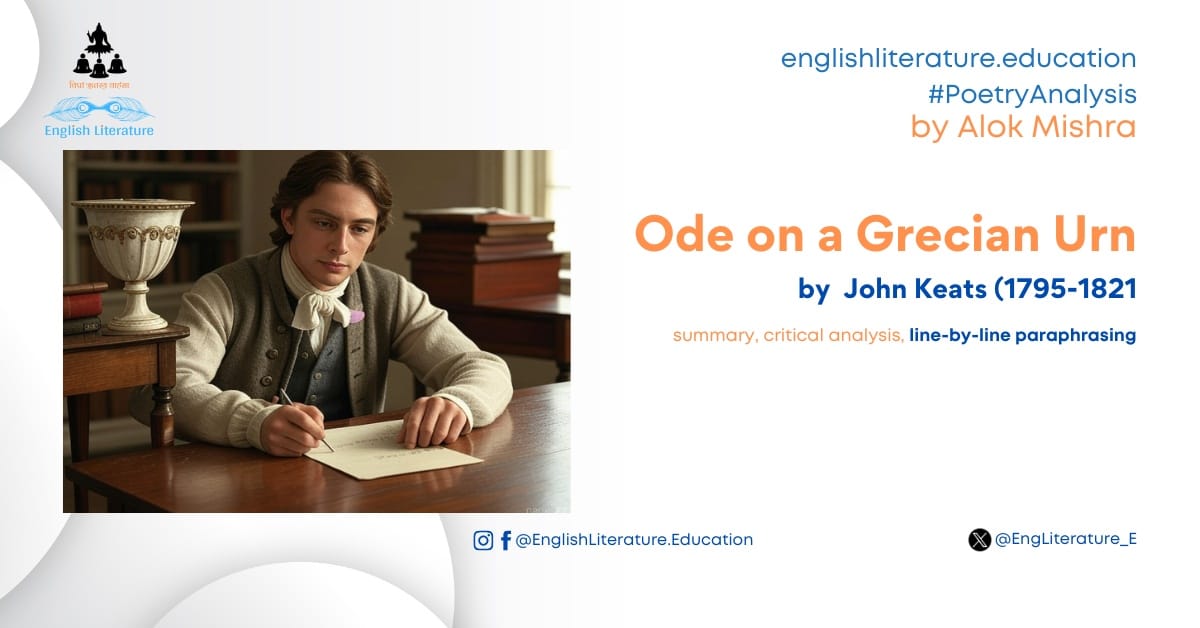Analysis of the Second Stanza from Ode on a Grecian Urn by John Keats
In this stanza, John Keats delves deeper into the theme of permanence versus transience. By meditation on the figures depicted on the urn, he explores the paradox of frozen, unchanging beauty and the emotional resonance it evokes. This stanza presents an interplay between sensual experience and imagination and the duality of fulfilment and frustration in the eternal.
The Text:
Line-by-Line Explanation
- “Heard melodies are sweet, but those unheard / Are sweeter; therefore, ye soft pipes, play on;”
- Keats contrasts sensory experience with the imagination. While melodies heard are enjoyable, those unheard are “sweeter” because they exist in the mind and are unbounded by reality. The urn’s imagery transcends physical sound, inviting the viewer to imagine eternal music untouched by decay or imperfection. The “soft pipes” symbolise this eternal harmony, urging them to “play on” in an infinite, idealised realm.
- “Not to the sensual ear, but, more endear’d, / Pipe to the spirit ditties of no tone:”
- The poet emphasises the superiority of the imagination over sensory perception. These “ditties of no tone” are internalised, resonating not with the physical senses but with the spirit. The phrase reflects Keats’s Romantic belief in the power of imagination to elevate human experience beyond physical limitations.
- “Fair youth, beneath the trees, thou canst not leave / Thy song, nor ever can those trees be bare;”
- The “fair youth” depicted on the urn is locked in an eternal moment beneath the boughs of a tree. He can never cease his song, as the scene on the urn is fixed in time. Similarly, the trees surrounding him will never shed their leaves, symbolising eternal spring—a perpetual state of life, beauty, and vitality.
- “Bold Lover, never, never canst thou kiss, / Though winning near the goal yet, do not grieve;”
- The “Bold Lover” is frozen at the brink of fulfilment. He can approach his beloved but can never consummate his love. The repetition of “never, never” underscores the tension between eternal anticipation and unattainable fulfilment. However, the poet consoles the Lover, suggesting that this eternal pursuit, free from the decay of time, is itself a kind of bliss.
- “She cannot fade, though thou hast not thy bliss, / For ever wilt thou love, and she be fair!”
- Like him, the lover’s beloved is frozen in an idealised state. Though he cannot attain his “bliss,” the consolation lies in her eternal beauty and his undying love. The stanza celebrates permanence: the lover’s passion and the beloved’s beauty are preserved forever, immune to the effects of time.
Themes in the Second Stanza
- Imagination vs. Reality
- The poet contrasts sensory experience with imaginative engagement. Heard melodies have limits, but the “unheard” melodies in the mind offer boundless possibilities.
- Permanence vs. Transience
- While human experiences are fleeting, art captures moments and emotions in an eternal, unchanging form. The lover’s pursuit remains eternally unfulfilled, but this very incompleteness ensures that his love and her beauty remain untarnished.
- Fulfilment vs. Frustration
- The lover’s inability to kiss his beloved reflects a paradox: though the act of fulfilment is denied, the emotions associated with the pursuit—anticipation, passion, and love—are preserved forever in their most intense state.
- The Role of Art
- The stanza underscores the power of art to immortalise beauty and human experience. While life is ephemeral, art arrests the fleeting moments, allowing them to exist in an idealised form for eternity.
Imagery and Symbolism
- “Heard melodies” and “unheard melodies”
- Symbolise the duality of sensory and imaginative experience. The unheard melodies are a metaphor for the limitless potential of the imagination.
- “Fair youth” and “Bold Lover”
- Represent the universal human experience of yearning, passion, and beauty, frozen in art yet alive in emotional resonance.
- “Trees that can never be bare”
- Symbolise eternal vitality and renewal, contrasting with the inevitable decay of nature in the real world.
Tone and Mood
- Tone
- Reflective and consoling. The poet acknowledges the tension between desire and fulfilment but ultimately celebrates the permanence of the depicted scene.
- Mood
- Both wistful and hopeful, as the poet balances the bittersweet nature of eternal incompletion with the joy of everlasting beauty.
Philosophical Reflection
Keats uses the figures on the urn to explore a philosophical paradox: in life, fulfilment is fleeting and often followed by loss, but in art, incompletion becomes a source of immortality. The youth and the lover are freed from time constraints; their experiences, though static, are preserved in a heightened state of perfection. The stanza illustrates Keats’s broader Romantic ideal that art transcends mortality and the limitations of human existence.
Concluding Remarks on the Stanza
This stanza exemplifies Keats’s mastery of blending sensual imagery with philosophical depth. By meditating on the figures frozen in time, he reflects on the nature of human desire, the fleetingness of life, and the timeless solace offered by art. In its silence and immobility, the urn speaks volumes about the eternal truths that govern human experience.
Navigation:
Stanza 1 – Stanza 2 (you are here) – Stanza 3 – Stanza 4 – Stanza 5
This article is a part of a series on Keats’ Ode on a Grecian Urn. You can read other articles by clicking the links below:
Ode on a Grecian Urn by John Keats: Summary & Critical Analysis
Figures of Speech, Poetic Devices in Ode on a Grecian Urn by John Keats
Prepared by A Mishra for ELE
…

